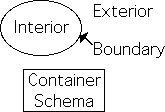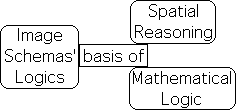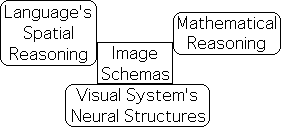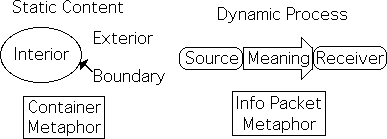Sight-based Image Schemas & Mathematical Logic
Logic of sight & sound are metaphorical blends
Let’s refine our understanding. In these many essays, the Author refers to the logic of sight and sound as if they were two opposing ‘entities’. This simplification facilitates comprehension. However, these ‘entities’ are actually metaphorical blends that consist of many parts. In similar fashion, the seemingly singular proton is a complex blend of subatomic interactions.
Logic of sight: a complex blend of image schema

The logic of sight that defines the scientific investigation is not singular in nature. Cognitive scientists have instead deconstructed the logic of sight into, what they call, image schema.
”Research in cognitive linguistics has shown that spatial relations in a given language decompose into conceptual primitives called image schema, and these conceptual primitives appear to be universal.” (Lakoff & Nunez, p. 30)
Container schema: Interior, Exterior & Boundary
There are many image schemas, for instance the Above schema, the Contact schema, and the Support schema. The crucial either-or metaphor of mathematics and logic is based in one of these image schemas, the Container schema.

“A common image schema of great importance in mathematics is the Container schema. The Container schema has three parts: an Interior, a Boundary and an Exterior. This structure forms a gestalt, in the sense that the parts make no sense without the whole. There is no Interior without a Boundary and an Exterior, no Exterior without a Boundary and an Interior, and no Boundary without sides, in this case an Inside and an Outside. This structure is topological in the sense that the boundary can be made larger, smaller, or distorted and still remain the boundary of the Container schema.” (Lakoff & Nunez, pp. 30-31)
The entire quotation is included to provide an understanding of a particular schema.
Image Schemas: the link between language & spatial perception
As is evident from the name, image schemas are based in sight. They play a crucial role in how we both perceive and talk about our world.

“Image schemas have a special cognitive function: They are both perceptual and conceptual in nature. As such, they provide a bridge between language and reasoning on the one hand and vision on the other. Image schemas can fit visual perception, as when we see the milk as being in the glass. They can also be imposed on visual scenes, as when we see the bees swarming in the garden, where there is no physical container that the bees are in. Because spatial-relations terms in a given language name complex image schemas, image schemas are the link between language and spatial perception.” (Lakoff & Nunez, p. 31)

Image Schemas have built-in Spatial ‘Logics’.
Language enables us to speak about space in a reasonable way. A precise logical blend underlies our schema-based language. ‘Visual logic’ or the ‘logic of sight’ are the terms the Author employs to categorize this complex logical blend of image schema.

“In addition, complex image schemas like In have built-in spatial ‘logics’ by virtue of their image-schematic structures. … Because image schemas have spatial logics built into their imagistic structure, they can function as spatial concepts and be used directly in spatial reasoning. Reasoning about space seems to be done directly in spatial terms, using image schema rather than symbols, as in mathematical proofs and deductions in symbolic logic.” (Lakoff & Nunez, p. 31)
Spatial ‘Logics’ of Image Schemas at the foundation of Mathematical Reasoning
Image schemas provide the logical background for our language-based spatial reasoning, not the symbols of math and logic. In addition to language, they also provide the underlying logical structure for mathematics and logic.

“Image schemas are kinesthetic, going beyond mere seeing alone, even though they use neural structures in the visual system. They can serve general conceptual purposes and are especially well suited for a role in mathematical thought. There are many image schemas that characterize concepts important for mathematics: centrality, contact, closeness, balance, straightness, and many, many more. Image schemas and their logics are essential to mathematical reasoning.” (Lakoff & Nunez, p. 34)
Image Schemas are embodied in the neural networks of the brain.

It is evident that image schemas play an incredibly important role in both language and mathematical logic. Accordingly, they influence how we reason about the world. These same image schemas are embodied in the neural structures of our visual system. Cognitive scientists have constructed "a computational neural model of a number of image schemas, as part of a neural simulation of the learning of spatial-relations terms in various languages." (Lakoff & Nunez, p. 33) One of the primary image schemas in this widely accepted model is the Container schema. This redundancy between language and the neural networks of our mind confirms the importance of these image schemas in determining how we think.
Image schema play a central role: linking language, brain, logic, and sight in one package.

Let us summarize the salient points. There are many image schemas that make up the logics of sight. These schemas are based upon direct visual experiences of space. The inferential structures of image schemas are embodied in the neural networks of the brain's visual cortex. Due, at least in part, to the mind/body connection, the multiple ‘logics’ of these visual experiences is how we come to reason, speak and comprehend our existence. The image schemas of sight are particularly important in mathematics and logic. Due to the linguistic roots of image schemas, all the linkages are metaphorical in nature. It is evident that the embodied image schemas play a central role in sensation, thought, language, and reasoning. Image schemas seem to be the common thread that links language, brain, logic, and our sense of sight into one integrated unit.
Author employs Inferential Structure of Visual Logic to understand Auditory Logic.
All Author’s cognitive info from 1 book that focused upon image schema.
Let me introduce a disclaimer at this point. The Author has derived virtually all of his information about image schemas from Where Mathematics Comes From by Drs. Lakoff and Nunez. They spent their mental energy upon the schemas that are important to mathematics in order to describe where it ‘comes from’. Due to the primacy of sight in science, schemas based in sound (‘auditory’ schema) were excluded from the discussion.
Auditory Logic of Info Packet metaphor more appropriate for Subatomic behavior, Living Algorithm & Life
However, the Author noticed that the auditory logic based in the Info Packet metaphor was particularly well suited to understanding subatomic behavior. The logic, the inferential structure, of the Info Packet metaphor also seems to apply to the Living Algorithm’s information system that characterizes living systems. However, the Author lacks technical expertise. As such, he employs the inferential structure of the Container schema without the scientific foundations in the following discussion of the Info Packet metaphor.
Understanding Info Packet metaphor via Inferential Structure of Container schema
More specifically, the Author identifies 3 components of his Info Packet metaphor, just as cogitive scientists have broken down the structure of the Container schema into 3 components. He further attempts to analyze the logical implications of the Info Packet metaphor in a similar fashion to Drs. Lakoff and Nunez, when they analyze the Container schema. However, as discussed, there is an abundance of scientific evidence in support of the Container schema, both neurologically and linguistically. The Info Packet metaphor has none.
Comparing & Contrasting Conceptual Metaphors: Visual & Auditory
In an attempt to avoid confusion, the Author will avoid the term 'schema' due to its precisely defined technical nature. Instead he will compare and contrast the Info Packet metaphor with the Container metaphor. The contrast is illuminating as one metaphor is sight-based, while the other is sound-based. The Container metaphor is one of the most studied conceptual metaphors of cognitive science. In contrast, the Info Packet metaphor has not been studied at all. Accordingly the Author attempts to provide some answers to the question: 'If the Info Packet is a conceptual metaphor, what are the implications?' To this end, he employs the inferential structure of the Container metaphor to the analyze the Info Packet, as a conceptual metaphor.
Despite technical shortcomings, the analyis is compelling due to what it reveals about Life.
In short, this discussion of a particular ‘auditory’ metaphor is non-technical. Despite this shortcoming, the analysis is impelling due to its many connections with experiential, sensory, experimental and logical reality. Further, the two metaphors provide a dividing line that differentiates Life and Matter – Mind and Body.
Container vs. Info Packet Metaphor
Container Metaphor stands for the Logics of Sight.
It is evident that visual logic consists of a complex blend of image schema, rather than being singular in nature. In this discussion, the Container schema (metaphor) has been the prime focus of our attention. In fact, the Author employs the Container metaphor to stand for the ‘logics of sight’. This conflation is partially due to its importance in the logic of mathematics, hence science. This simplification is for ease of communication and is not meant to be taken literally.
Info Packet Metaphor stands for the Logics of Sound.
Similarly in these essays regarding subatomics, the ‘logics of sound’ is based in what the Author calls the Info Packet metaphor. In this context, auditory logic does not include all phenomena associated with sound. Instead, the logic of sound is restricted to the transmission of meaningful information between 2 sources. The physical characteristics of sound are excluded from the discussion.
3 Elements of Container & Info Packet Metaphor
The three crucial elements of the Container schema are an Exterior, Interior, and Boundary. These 3 elements are in a static relationship to each other. The three crucial elements in the Info Packet ‘schema’ are Informational Meaning, a Source, and a Receiver. These 3 elements are in a dynamic relationship with each other. As is evident, our Info Packet metaphor is based in process, while the Container metaphor is based in content.

Container & Transmission structures form gestalts
Just as the structure of the Container schema forms a gestalt, the Info Packet structure also forms a gestalt. These logical structures form gestalts, “in the sense that the parts make no sense without the whole.” Although the function of each element is unique, the Source must have Information to transmit and a Receiver to understand the meaning of the Information for the process to be complete.
Of Boundaries & Essences
Static Container Metaphor requires a Boundary
The Container metaphor of science requires a Boundary to determine what is Inside and Outside a category box. Science focuses upon the absolute essences of objects to determine whether something is inside or outside this category box. While these boxes might include processes, the boxes are static. The Container metaphor is based upon fixed content with absolute essences. This description fits the indestructible atom. As such, we suggest that the logic of this metaphor is most appropriate to symbolize the behavior of Matter in our atom-based world.

Dynamic Info Packet Metaphor has no Boundary, therefore no Absolute Essences.
In contrast, the Info Packet metaphor has no Boundary. Instead, it is a dynamic process based upon variable content with changeable essences. The metaphor can include objects in a process, but is not an object. A process is constantly changing. While it might have a beginning and an end, there is no standing still. A process can yield a result, but is not a result. Essences are constantly changing.
Info Packet Metaphor for the changeable Essences of the transient Subatomic World
This description fits the constantly changing nature of subatomics. For instance, scientists can observe subatomic results, but subatomics are constantly disappearing and reappearing, as they change from one form to another. The electron/photon complex is generally in a constant state of flux. It is impossible to determine from one moment to the next whether the subatomic is an electron or a photon – much less whether it behaves like a wave or particle. Due to these congruencies, we suggest that the inherent logic of the Info Packet metaphor is appropriate to describe the transient nature of the subatomic world.

Info Packet Metaphor for the Transient Nature of Living Matter
In this model, there are 3 types of matter: atom-based, subatomic, and living. The Container metaphor seems most appropriate for the fixed nature of atom-based matter, while the Info Packet metaphor better characterizes the transient nature of the subatomic matter. The logic of the Info Packet metaphor also fits the constantly changing nature of living systems. As such, we suggest that the logic of this metaphor is most appropriate to symbolize the dynamic behavior of Life – transient living matter.

The Info Packet metaphor, an Auditory Logic, requires Meaning
Meaning relevant for Life, not Matter
Just as a Boundary with an Inside and Outside are crucial features of the Container metaphor, Meaning is a crucial feature of our Info Packet metaphor. The contrast is complete. The Container metaphor includes a Boundary, but no Meaning. The Info Packet metaphor includes Meaning, but no Boundary. Further, Meaning is only associated with Life. Life, as the urge to actualize, must extract meaning from environmental information in order to fulfill potentials. Conversely, there is no meaning for Matter, which reacts automatically to environmental stimuli.

Due to Meaning, Info Packet metaphor more appropriate for Life
Meaning is not transmitted in the fixed Container metaphor. As such, the ‘logic’ that underlies this metaphor is ideal for material systems and less than ideal for living systems, which are all about extracting meaning. The Info Packet metaphor is more appropriate for living systems, as meaning is an innate feature of its logical structure. From this perspective, it is not surprising that material scientists have embraced the inferential logical structure of the Container metaphor and ignored the logic of the Info Packet metaphor.
Material Science ignores differences between hands & sticks.
Susan Langer gives voice to the dichotomy between matter and life, when she writes about the beginning of Western thought in Greece.

“To the physicists, eyes and hands were no more interesting than sticks and stones. They were all just varieties of Prime Matter. The Socratic conception of purpose went beyond the old physical notions in that it gave importance to the differences between men’s hands and other ‘mixtures of elements’.” (Philosophy in a New Key, 1942, p. 9)
Humans supply the Meaning behind Information.
This dichotomy still exists over 2 millennia later. It is epitomized in the separation of science into two parts, Material and Life. Feynman’s subatomic science deconstructs our physical world into interactions between photons and electrons. The logical system is based in part upon the Container metaphor with its Boundary. Yet this materialist mindset is unable to differentiate between a hand and a stick. In contrast, humans must be able to understand the meaning behind visual input in order make this differentiation. Information, by itself, is inert. Humans supply meaning to information. An essence of the Info Packet metaphor is Meaning.
Electronic Information Processing does not supply Meaning.
The information processing associated with machines does not supply meaning. There is no transmission of meaning, just an exact replication of information. A human must digest the information on a CD or DVD to extract meaning from the words, music, or pictures.

Living Algorithm links Past with Present to provide an Essence of Meaning.
The Living Algorithm provides a method for digesting information that connects past events with the present. This connectivity with the past is a crucial feature of meaning. The past supplies the context that provides the meaning behind events. Because matter responds automatically it requires no memory of the past to supply the context that is an essence of meaning.
Life generates Future Expectations with the Living Algorithm’s derivatives.
The Living Algorithm computes rates of change (derivatives) of data streams. These rates of change are based upon what went before. Living systems also generate expectations regarding the future based upon these data stream derivatives. These expectations are also a factor in determining the meaning behind sensory information. Our expectations regarding behavior determine the meaning behind our response. Knowing whether to mate, eat, or fight with the source of sensory input is crucial to our survival.

Meaning: Life‘s urge, the Living Algorithm's digestion process & Info Packet’s Logic

In summary, determining meaning is an essential feature of living systems. Life, at whatever level of the biological hierarchy, must extract meaning from the stream of environmental information to satisfy her innate urge to fulfill potentials. The Living Algorithm’s digestion process provides the temporal connectivity that is at the heart of meaning. The Info Packet metaphor supplies the inferential logic behind meaning.
Link
What is the inferential structure behind the sound-based Info Packet metaphor? And how does this differ from the inferential structure of the sight-based Container metaphor? What are the implications? We certainly don't know. For some plausible suggestions as to the answers, check out the next article in the stream –